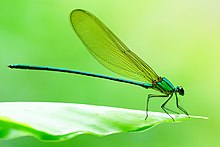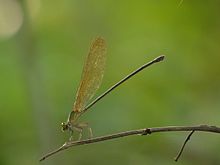| Clear-winged forest glory | |
|---|---|

| |
| Male | |

| |
| Female | |
| Conservation status | |
 Least Concern (IUCN 3.1) | |
| Scientific classification | |
| Domain: | Eukaryota |
| Kingdom: | Animalia |
| Phylum: | Arthropoda |
| Class: | Insecta |
| Order: | Odonata |
| Suborder: | Zygoptera |
| Family: | Calopterygidae |
| Genus: | Vestalis |
| Species: | V. gracilis |
| Binomial name | |
| Vestalis gracilis (Rambur, 1842) | |
| Synonyms | |
|
Calopteryx gracilis Rambur, 1842 | |


Vestalis gracilis, is a species of damselfly belonging to the family Calopterygidae. It is known commonly as the clear-winged forest glory or clear-winged flash-wing. It is native to Southeast Asia and surrounding regions.
Description
The male and female are similar in size; the male having an abdomen 45 to 46 millimeters long and a hindwing 34 to 38 millimeters long and the female with an abdomen 43 to 50 millimeters long and a hindwing 36 to 39 millimeters long.
The male is iridescent green with a yellow and black underside. It has brown legs and blue-tinged transparent wings. The eyes are dark brown above and greenish yellow below. The female is duller greenish brown in color.
Habitat
This is a common species across much of its range. It breeds in forest streams, often in disturbed and cultivated areas too. Commonly seen as a group rest among bushes in forest paths and shades together with Vestalis apicalis.
Subspecies
A subspecies, V. g. montana Fraser, 1934, has been described from Western Ghats of South India. It is now synonymised with V. a. submontana and is considered as a separate species Vestalis submontana.
See also
References
- ^ Dow, R.A. (2009). "Vestalis gracilis". IUCN Red List of Threatened Species. 2009: e.T163667A5632782. doi:10.2305/IUCN.UK.2009-2.RLTS.T163667A5632782.en. Retrieved 19 November 2021.
- ^ Paulson, D.; Schorr, M.; Abbott, J.; Bota-Sierra, C.; Deliry, C.; Dijkstra, K.-D.; Lozano, F. (2024). "World Odonata List". OdonataCentral, University of Alabama.
- ^ M. Hamalainen. "Calopterygoidea of the World" (PDF). caloptera.com. Retrieved 2017-02-20.
- ^ "Vestalis gracilis Rambur, 1842". India Biodiversity Portal. Retrieved 2017-02-20.
- ^ "Vestalis gracilis Rambur, 1842". Odonata of India, v. 1.00. Indian Foundation for Butterflies. Retrieved 2017-02-20.
- K.A., Subramanian; K.G., Emiliyamma; R., Babu; C., Radhakrishnan; S.S., Talmale (2018). Atlas of Odonata (Insecta) of the Western Ghats, India. Zoological Survey of India. pp. 70–71. ISBN 9788181714954.
- ^ Subramanian, K. A. (2005). Dragonflies and Damselflies of Peninsular India - A Field Guide.
- ^ C FC Lt. Fraser (1934). The Fauna of British India, including Ceylon and Burma, Odonata Vol. II. Red Lion Court, Fleet Street, London: Taylor and Francis. pp. 126-130.
- C FC Lt. Fraser (1924). A Survey of the Odonate (Dragonfly) Fauna of Western India and Descriptions of Thirty New Species (PDF). p. 479.
- M. Hamalainen. "NOTES ON THE TAXONOMIC STATUS OF VESTALIS SUBMONTANA ERASER, 1934 FROM SOUTH INDIA (ZYGOPTERA: CALOPTERYGIDAE)" (PDF). caloptera.com. Retrieved 2017-02-20.
External links
![]() Data related to Vestalis gracilis at Wikispecies
Data related to Vestalis gracilis at Wikispecies
![]() Media related to Vestalis gracilis at Wikimedia Commons
Media related to Vestalis gracilis at Wikimedia Commons
| Taxon identifiers | |
|---|---|
| Vestalis gracilis | |
This article related to Calopterygoidea is a stub. You can help Misplaced Pages by expanding it. |